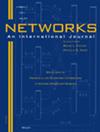Reducing police response times: Optimization and simulation of everyday police patrol
IF 1.3
4区 计算机科学
Q4 COMPUTER SCIENCE, HARDWARE & ARCHITECTURE
引用次数: 0
Abstract
Police forces around the world are adapting to optimize their current practices through intelligence‐led and evidence‐based policing. This trend towards increasingly data‐driven policing also affects daily police routines. Police patrol is a complex routing problem because of the combination of reactive and proactive tasks. Moreover, a trade‐off exists between these two patrol tasks. In this article, a police patrol algorithm that combines both policing strategies into one strategy and is applicable to everyday policing, is developed. To this end, a discrete event simulation model is built that compares a p‐median redeployment strategy with several benchmark strategies, that is, p‐median deployment, hotspot (re)deployment, and random redeployment. This p‐median redeployment strategy considers the continuous alternation of idle and non‐idle vehicles. The mean response time was lowest for the p‐median deployment strategy, but the redeployment strategy results in better coverage of the area and low mean response times.缩短出警时间:日常警察巡逻的优化与模拟
世界各地的警察部队都在进行调整,通过情报主导和循证警务来优化其现行做法。这种日益以数据为导向的警务趋势也影响着日常警务工作。警察巡逻是一个复杂的路由问题,因为它既要执行被动任务,又要执行主动任务。此外,这两项巡逻任务之间还存在权衡问题。本文开发了一种警察巡逻算法,它将两种警务策略合二为一,并适用于日常警务工作。为此,本文建立了一个离散事件仿真模型,将 p 中值重新部署策略与几种基准策略(即 p 中值部署、热点(重新)部署和随机重新部署)进行比较。这种 p 中值重新部署策略考虑了空闲和非空闲车辆的连续交替。p-median 部署策略的平均响应时间最短,但重新部署策略的区域覆盖率更高,平均响应时间更短。
本文章由计算机程序翻译,如有差异,请以英文原文为准。
求助全文
约1分钟内获得全文
求助全文
来源期刊

Networks
工程技术-计算机:硬件
CiteScore
4.40
自引率
9.50%
发文量
46
审稿时长
12 months
期刊介绍:
Network problems are pervasive in our modern technological society, as witnessed by our reliance on physical networks that provide power, communication, and transportation. As well, a number of processes can be modeled using logical networks, as in the scheduling of interdependent tasks, the dating of archaeological artifacts, or the compilation of subroutines comprising a large computer program. Networks provide a common framework for posing and studying problems that often have wider applicability than their originating context.
The goal of this journal is to provide a central forum for the distribution of timely information about network problems, their design and mathematical analysis, as well as efficient algorithms for carrying out optimization on networks. The nonstandard modeling of diverse processes using networks and network concepts is also of interest. Consequently, the disciplines that are useful in studying networks are varied, including applied mathematics, operations research, computer science, discrete mathematics, and economics.
Networks publishes material on the analytic modeling of problems using networks, the mathematical analysis of network problems, the design of computationally efficient network algorithms, and innovative case studies of successful network applications. We do not typically publish works that fall in the realm of pure graph theory (without significant algorithmic and modeling contributions) or papers that deal with engineering aspects of network design. Since the audience for this journal is then necessarily broad, articles that impact multiple application areas or that creatively use new or existing methodologies are especially appropriate. We seek to publish original, well-written research papers that make a substantive contribution to the knowledge base. In addition, tutorial and survey articles are welcomed. All manuscripts are carefully refereed.
 求助内容:
求助内容: 应助结果提醒方式:
应助结果提醒方式:


